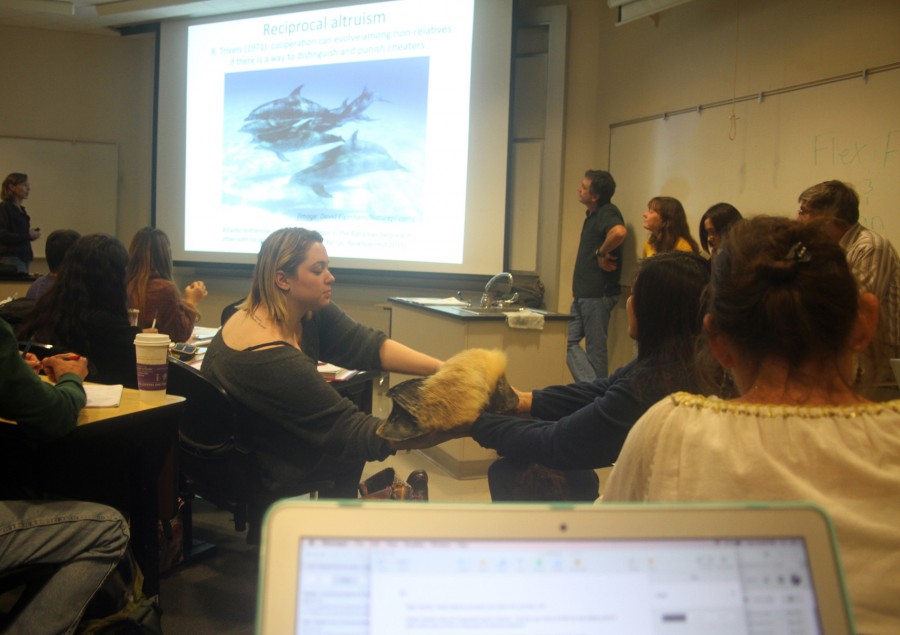Science Lecture Informs Students of Endangered Species
SHARKS & WHALES: Students pass around a baleen (containing a series of stiff, flexible material that hang from a baleen whale’s upper jaw) during a lecture on Nov. 24 in the Cimmarusti Science Center.
Javier Gago and Maria Kretzmann presented two lectures on biodiversity that attracted more than 90 students, some forced to sit in the aisles, to the Cimmarusti Science Center Nov. 24.
Titled “Sharks and Whales in the Sea of Cortez: Biodiversity and Conservation,” the lectures touched upon some of the problems surrounding the conservation of these two animals.
The two professors also provided an overview of the Baja Program. Headed jointly by the Gago and Kretzmann, this particular field studies program offers students the chance to travel to Baja and study the biodiversity that exists on the peninsula.
“Overall, I am hoping to learn more about how to link animals and their behavior to humans and our culture … and also understand more about how animals have their own sense of culture,” said Sandy Tran, a student majoring in criminology.
Gago’s lecture depicted the grim reality of shark hunting, however, he kept the audience engaged with an occasional joke.
“You’re all familiar with sharks, of course,” Gago said. “Sharks are all bad and they’re trying to eat you up so we should get rid of them.”
As the audience broke into laughter, Gago directed them back to the seriousness of the topic. While most people may view sharks as harmful or villainous, he said, the reality is that sharks have a little more to worry about than humans do.
“In fact, there is about one human casualty for every 10 million sharks killed by humans,” Gago said. These high numbers of shark deaths are largely due to faulty belief that shark fins and cartilage have cancer-curing properties Gago explained.
“The FDA has conducted randomized trials and found there is no evidence proving cartilage from sharks prevents cancer,” Gago said.
He concluded his presentation by encouraging students to independently research facts before they deem them accurate.
“Now we go from the bad guys, the sharks, to the good guys: the whales,” Gago said jokingly as he welcomed Kretzmann to begin her lecture.
Kretzmann discussed some of the characteristics that make dolphins unique, namely the relatively large size of their brains and their human-like cooperative behavior. This behavior can be seen in the ways dolphins help each other with foraging and babysitting, Kretzmann said.
Her lecture moved forward with a discussion of the Vaquita dolphin, an endangered species that has less than 100 individuals remaining. It is under threat mostly due to gillnet shrimp fishing, which traps the dolphins causing them to drown when they cannot reach the surface to breathe.
“[The Vaquita dolphins] are probably going to disappear within the next decade unless we are extremely lucky,” Kretzmann said.
In an attempt to save these animals, the Mexican government has passed a law that will ban gillnet fishing for the next two years while compensating the fishermen for their loss.
To segway into the final portion of the day’s lectures, Kretzmann gave audience members a glimpse into the kinds of hands-on learning students can expect in Baja as she told the story of when she saw a blue whale for the first time.
“This was the most exciting day of my life,” Kretzmann said.
“We followed a blue whale for an entire morning with the field class. I never thought I would see one. This is the largest animal that has ever lived on earth.”
Gago joined Kretzmann on the stage to discuss the details of the Baja program and how students can sign up to participate.
“I was pleased to see that they were excited about the subject,” said Melineh Hairapetian, a third-year student majoring in environmental science.
“I have been to a lot of lectures and there are a lot of people who are knowledgeable but are not very good at conveying their passion. Professor Gago and Professor Kretzmann did a wonderful job engaging the audience,” Hairapetian said.
“I wish (the lecture was longer,” said Nelli Astvatsatrian, art major. “I think it’s great that GCC has stuff like this.

Irene Abramian is of Armenian descent, was born and raised in Sweden and has lived in the US for a little over 10 years. Coming from a multi-cultural background,...

